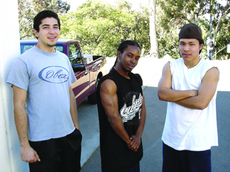There is a growing trend in many college towns and major cities across the United States and its called Hookah.
It is a way to smoke flavored tobacco filtered through water in a pipe, called a hookah. The popularity of hookah smoking has been on the rise in recent years, with new hookah bars sprouting up all over the United States, especially in California.
It is generally believed that hookah smoking originated in north-western India nearly a thousand years ago. It was originally used for smoking Opium and Hashish and was later adapted for use in smoking tobacco.
There are over 20 hookah smoking establishments here in San Diego alone.
Hookah bars are becoming an increasingly popular place to socialize on a Friday or Saturday night for college students age 18-20 who cannot go to normal bars yet.
“Smoking shisha doesn’t seem as bad as smoking cigarettes,” said Shawn Astaraei, a 19-yr old Mesa College student. “It’s filtered and the flavored smoke feels better on your throat and lungs, but I have heard that it is worse for you than cigarettes.”
Many people consider hookahs to be safer than other forms of tobacco smoke.
However, experiments performed by health experts over the past few years have produced a different conclusion.
Studies by The World Health Organization, The American Lung Association, as well as many other reputable organizations have determined that smoking hookah is actually more dangerous and unhealthy than smoking cigarettes.
Hookah tobacco contains all the same chemicals as other forms of tobacco, and generally in higher concentrations. It has also been found to contain heavy-metals such as arsenic, cobalt, chromium, cadmium, lead and nickel.
For example, a study by the World Health Organization published in June of last year, found that the average hookah smoker may inhale as much smoke in one session as a cigarette smoker would inhale consuming 100 or more cigarettes.
The amount of tar yielded per gram of hookah tobacco is nearly 100 times that produced per gram of cigarette tobacco.
In an article published by the Tobacco-Related Disease Research Program in August of last year, nicotine levels of hookah smokers were measured during the session and for a period after. It was found that to achieve the same levels of nicotine during and after a hookah session, smokers would have to chain-smoke 15 cigarettes.
Second-hand smoke from hookahs poses as great a risk to non-smokers as does cigarette smoke. In fact, according to the WHO study, the charcoal fuel used to burn the tobacco emits carbon monoxide, or CO, which is a deadly gas in large quantities.
Sharing a hookah mouthpiece has also been positively linked to the spread of communicable diseases like hepatitis and tuberculosis, which is not widespread here in the United States, but poses a serious health risk in many other countries.
According to a SDSU study published in 2005, hookah use was suggested to be positively associated with coronary heart disease, as well as lung, oral, and bladder cancers.
The growing rate which teen and college-age people are taking up smoking hookah is alarming to many within the health community. Hookah smoking does not yet have the same bad stigma associated with cigarettes, and the tropical flavors make it enticing to young people.
Health advocates are hoping that these studies as well as others in progress can dissuade people from smoking, however only time will tell if hookahs are here to stay.

